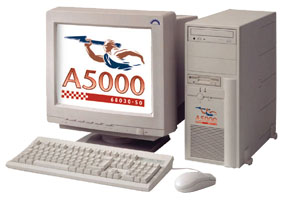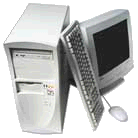
Power A5000
Developer: Power Computing
Announced: 1997
Cancelled: 1999 |

The A5000 was one of the first Amiga clones announced following
the Gateway purchase (1997). The joint DCE/Power Computing project
was a mid-range system based upon a new motherboard design. Like
the BoXeR it was to be entirely modular, opening the way for a
range of market specific systems. The original specification list
indicated the machine would include the following:
| Motherboard |
Baby AT-size 100% Amiga-compatible |
| Processor |
Motorola 68030/50 MHz or 68040 |
| Chipset |
AGA |
| Memory |
2Mb Chip, 4Mb Fast (up to 64Mb fast RAM) |
| Drives |
1.44 MB floppy drive,
1.7 GB IDE hard drive,
10 - 24 speed IDE CD-ROM, |
| Expansion |
Dual IDE interface,
4 Zorro 2 slots,
A bus slot for the addition of accelerators and MPEG card, |
| Additional |
MPEG level 1 supported,
PC or Amiga keyboard,
A scan doubler for use with cheap PC monitors,
Possible addition of PowerPC interface |
| Case |
ATX case (AT motherboard in an ATX case?) |
After the WOA98 announcement it seemed the "Classic" market was
now dead and the new motherboard design was abandoned. Towards the
end of 1998 the 68k Amiga situation brightened when it became clear
that the "AmigaNG" development would not mean an end to the Classic
market. With additional interest in development, Power Computing
examined previous plans to develop a new Amiga motherboard.
However, the added cost of upgrading and manufacturing prototypes
in the shrinking market caused them to abandon previous plans.
Instead, the A5000-Mark 2 would be based upon the standard A1200
motherboard and 3rd party hardware to give a much needed
performance boost.

The first sign of the revised A5000 came in the April 1999 edition
of Amiga Format. Its feature list read:
- PowerPC G3 compatibility through Escena Brainstormer G3.
- 68k emulation
- WarpUp PPC software
- A1200 accelerator slot compatible
- Flicker Fixer
- 3x Active PCI slots
- ATX motherboard
- 2x A4000-style videoslots
- Connector for Zorro backplane
Soon after the announcement was made Power canceled it once again.
The reason behind this seems threefold:
- MIND SHARE: In light of announcements during
1999 it seemed suicidal to sell an Amiga when attention was
focussed upon the soon to be released Amiga MCC.
- MARKET SHARE: In comparison to the BoXeR, the
frankenstein design of the A5000 seemed to attract few fans from
the Classic market.
- SOFTWARE SUPPORT: It is painfully obvious the
hardware/software for such a machine would be unavailable until
mid-2000 at the earliest. The Escena developers have also been
silent for some time leading to speculation that the project has
been canceled.
In conclusion, the A5000 was an interesting project that came to
late. If it had been released during 1997 it may have had some
commercial success from people seeking to upgrade their Amiga.
Unfortunately its continued delay coincided with announcements by
Amiga Inc. that managed to kill off any market support it may have
had. It was a distraction to the main events, nothing more.
BACK
Last Update: 1/11/2001
|













